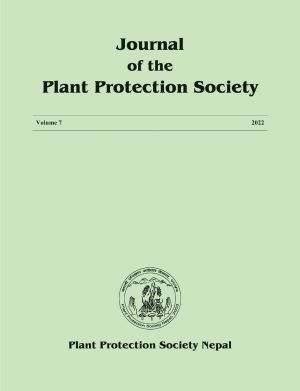Pathotypes Diversity of Puccinia striiformis causing Yellow Rust of Wheat in Nepal
DOI:
https://doi.org/10.3126/jpps.v7i01.47293Keywords:
Monitoring, pathotypes, Puccinia striiformis, wheat, yellow rustAbstract
Wheat (Triticum aestivum) is one of the major stable crop in Nepal. The area of cultivation of wheat is increasing compared to last decade; but its productivity is almost stagnant due to several limiting factors among them, yellow rust caused by Puccinia striiformis is one of the major responsible factors. Rust monitoring was carried out to determine the pathotypes diversity of P. striiformis during 2018-2021. A total of 109 samples were collected from 41 districts of seven provinces. Each yellow rust samples multiplied in susceptible cultivar and inoculated in differential set for rust pathotypes analysis. The diversity of pathotypes was observed across the country. Seven pathotypes (238S119, 110S119, 46S119, 47S103, 6S0, 78S84 and 110S84) were recorded with different severity level. The pathotypes 46S119, 110S119 and 238S84 found as predominant in different locations. The severity level ranged from resistant to highly susceptible depending on location and genotypes. The severity level was comparatively higher in western-mid-hill than eastern-mid-hill. The change in pathotypes diversity may be resulted by selection pressure due to the adoption of new wheat genotypes. Monitoring rust pathotypes is essential to develop a strategic plan for yellow rust management by deploying resistant gene/s in wheat genotypes.
Downloads
Downloads
Published
How to Cite
Issue
Section
License

This work is licensed under a Creative Commons Attribution-NonCommercial 4.0 International License.
© Plant Protection Society of Nepal

